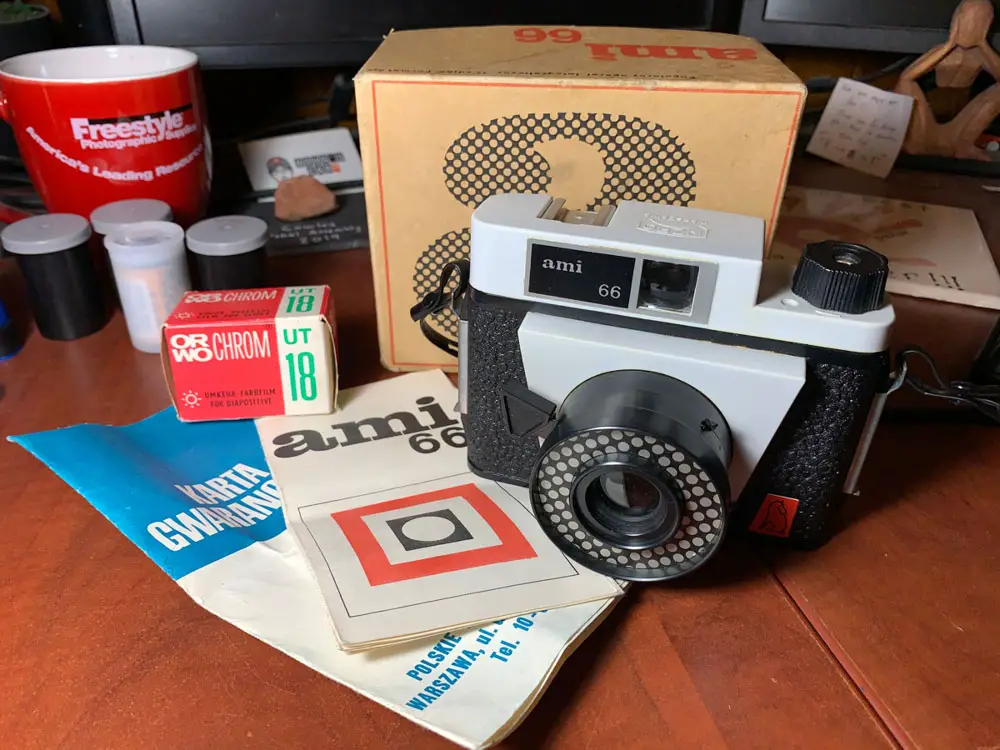5 Frames… On the high-impact polystyrene Ami 6×6 with Arista.EDU Ultra 100 (EI ??? / 120 format) – by Brian DuBois
I love Black and White film. Historically, it is where photography began and the process allows for so much personalization with multiple film and developer choices. As part of the historical fascination, I love looking at cameras from around the world; especially those accessible to the everyday person. This naturally leads to former Soviet Union cameras and lenses such as the Helios-44 and Zenit cameras. I have several and in looking for something different, I was introduced to the 6x6cm medium format film Polish Ami 66.

The Ami 66 is a Polish-made camera designed to be easy to use. It is a “styropol” (Polish high impact polystyrene) bodied camera with a fixed focus, single element 75mm f/8 lens. The shutter is a fixed 1/50th of a second (M) with an option for long exposures (B), and there are two aperture stops denoted by symbols: cloud (f/8) and sun (f/16). The film plane is curved to try and compensate for the lack of sharpness of a single element lens. The exterior is styled with a nice pop-culture look including a polka dot surround encircling the lens (likely mimicking selenium cells popular in the 60s). My friend in Poland was able to find an example made in 1976 and sold in 1977 per the paperwork included in the original box.
When it comes to vintage cameras with slow shutters, I turn to Arista.EDU Ultra 100 ( aka Fomapan 100 Classic), as it gives a classic look and seems more than happy to be exposed at EI 25 or EI 50, making it the perfect companion to box cameras. The shutter was a bit rough, so I took a moment to clean and lubricate it, dramatically improving the feel. I loaded up a roll and carried it around Buhl, Idaho to document life as the camera was designed to do.
My expectations were quite low, as this camera has essentially the same specs as a Holga or Diana, but built to 1970s Eastern Bloc standards. There is something really nice about shooting such a basic camera. You really only have to think about composition and trying to keep such a light thing still when shooting. I shot using the sun and cloudy symbol according to conditions and made a little tape flap to cover the red frame counter window as an extra precaution.





I shot my roll over a couple days and was a bit nervous to see the results. The first roll through any camera is always a bit of a mystery: would there be light leaks? Would all the frames suffer from camera shake? I loaded up the development tank and used my HC-110 recipe for high contrast on AristaEDU.100. When I pulled the negatives from the tank, I was pleasantly surprised with the results.
It’s no competitor to my “proper” medium format cameras, but it has a wonderful charm to it.
~ Brian
Submit your 5 Frames… today
Get your own 5 Frames featured by submitting your article using this form or by sending an email via the contact link at the top of the page.
Share your knowledge, story or project
The transfer of knowledge across the film photography community is the heart of EMULSIVE. You can add your support by contributing your thoughts, work, experiences and ideas to inspire the hundreds of thousands of people who read these pages each month. Check out the submission guide here.
If you like what you’re reading you can also help this passion project by heading over to the EMULSIVE Patreon page and contributing as little as a dollar a month. There’s also print and apparel over at Society 6, currently showcasing over two dozen t-shirt designs and over a dozen unique photographs available for purchase.








2 responses to “5 Frames… On the high-impact polystyrene Ami 6×6 with Arista.EDU Ultra 100 (EI ??? / 120 format)”
The lens has a waterfall stop aperture for sunny conditions, so I am thinking the ring is basically a flare from that aperture hole. It’s a neat effect.
This was designed as a serious but simple camera for Polish folks so while it looks a bit like a Diana or Holga, it’s built to a (slightly) higher standard.
Nice work. Since you describe camera as being like Holga or Diana, I was expecting more vignetting than what you got. On the other hand you got a ring of light on the 5th image. Do you have any idea about that – how it happened?
Thanks for posting.